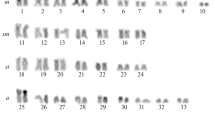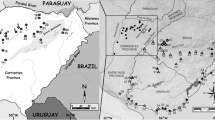Abstract
We present the results of a cytogenetic study on Mus (Nannomys) minutoides from Kenya by means of C- and G- banding and in-situ fluorescence hybridization (FISH) to localize the telomeric sequences. The karyotype is characterized by the occurrence of several Rb chromosomes Rb(1.X), Rb(1.Y). Rb(2.17), Rb(3.13), Rb(4.10), Rb(5.11), Rb(6.7), Rb(8.12), not previously described for this species. This finding suggests a high level of chromosomal diversification, which means it is possible to consider this cytotype as a new, well-differentiated, chromosomal lineage within the subgenus. The C-banding of the metaphases illustrated conspicuous blocks of centromeric heterochromatin at the paracentromeric regions of all telocentric chromosomes. Centromeric heterochromatin is not visible on all biarmed chromosomes. Following hybridization with telomeric probes, bright interstitial telomeric sequence (ITS) fluorescence signals are evident at the pericentromeric area of all Rb chromosomes, with the exception of Rb(2.17). Considering the localization of the C-positive heterochromatin and of the telomeric sequences, the events leading to the Kenyan cytotype from an all-telocentric condition probably included two steps: first, fusion without loss of heterochromatin and pericentromeric telomeric sequences; second, the reduction of the C-positive satellite DNA followed by the amplification of telomeric sequences in the C-negative paracentromeric region of Rb chromosomes. The presence of a single Rb(2.17) without ITS indicates possible variations of this mechanism.
Similar content being viewed by others
References
Aniskin VM, Lavrenchenko LA, Varshavskii AA, Milishnikov AN (1998) Karyotypes and cytogenetic differentiation of two African mouse species of the genus Mus (Rodentia, Muridae). Russ J Genet 34: 80–85.
Ashley T (2002) X-autosome translocations, meiotic synapsis, chromosome evolution and speciation. Cytogenet Genome Res 99: 303–309.
Castiglia R, Gornung E, Corti M (2002) Cytogenetic analyses of chromosomal rearrangements in Mus minutoides/musculoides from North-West Zambia through mapping of the telomeric sequence (TTAGGG)n and banding techniques. Chromosome Res 10: 399–406.
Dobigny G, Ozouf-Costaz C, Bonillo C, Volobouev V (2003) Evolution of rRNA gene clusters and telomeric repeats during explosive genome repatterning in Taterillus X (Rodentia, Gerbillinae). Cytogenet Genome Res 103: 94–103.
Dobigny G, Ozouf-Costaz C, Bonillo C, Volobouev V (2004) Viability of X-autosome translocations in mammals: an epigenomic hypothesis from a rodent case-study. Chromosoma 113: 34–41.
Fajkus J, Sykorova E, Leitch AR (2005) Telomeres in evolution and evolution of telomeres. Chromosome Res 13: 469–479.
Garagna S, Broccoli D, Redi CA, Searle JB, Cooke HJ, Capanna E (1995) Robertsonian metacentrics of the mouse lose telomeric sequences but retain some minor satellite DNA in the pericentromeric area. Chromosoma 103: 685–692.
Garagna S, Ronchetti E, Mascheretti S et al. (1997) Non-telomeric chromosome localisation of (TTAGGG)n in the genus Eulemur. Chromosome Res 5: 487–491.
Hsu TC, Patton JL (1969) Bone marrow preparations for chromosome studies. In Benirschke K, ed., Comparative Mammalian Cytogenetics. Berlin: Springer-Verlag, pp. 454–460.
Jaafar H, Gabriel-Robez O, Rumpler Y (1993) Chromosomal anomalies and disturbance of transcriptional activity at the pachytene stage of meiosis: relationship to male sterility. Cytogenet Cell Genet 64: 273–280.
Jotterand-Bellomo M (1984) L’analyse cytogénétique de deux espéces de Muridae africains, Mus oubanguii et Mus minutoides/musculoides: polymorphisme chromosomique et é bauche d’une phylogénie. Cytogenet Cell Genet 38: 182–188.
Jotterand-Bellomo M (1986) Le genre Mus africain, un exemple d’homogénèité caryotypique: étude cytogénétique de Mus minutoides/musculoides (Côte d’Ivoire) de M. setulosus (Republique Centrafricaine), et de M. mattheyi (Burkina Faso). Cytogenet Cell Genet 42: 99–104.
King M (1993) Species Evolution. The role of the chromosomal change. Cambridge: Cambridge University Press.
Lansdorp PM, Verwoerd NP, van de Rijke FM et al. (1996) Heterogeneity in telomere length of human chromosomes. Hum Mol Genet 5: 685–691.
Liao D (1999) Concerted evolution: molecular mechanism and biological implications. Am J Hum Genet 64: 24–30.
Matthey R (1966) Le polymorphisme chromosommique des Mus africains du sous-genre Leggada. Reévision générale portant sur l’analyse de 213 individus. Rev Suisse Zool 73: 585–607.
Matthey R (1970) L’éventail ‘Robertsonien’ chez les Mus (Leggada) Africains du groupe minutoides/musculoides. Rev Suisse Zool 77: 625–629.
Metcalfe CJ, Eldridge MDB, Toder R, Johnston PG (1998) Mapping the distribution of the telomeric sequence (T2AG3) Macropodoidea (Marsupialia), by fluorescence in situ hybridization. I. The swamp wallaby, Wallabia bicolour. Chromosome Res 6: 603–610.
Meyne J, Baker RJ, Hobart HH et al. (1990) Distribution of non-telomeric sites of the (TTAGGG)n telomeric sequence in vertebrate chromosomes. Chromosoma 99: 3–10.
Musser GG, Carleton MD (2006) Superfamily Muroidea. In Wilson DE, Reeder DH, eds., Mammal Species of the World. A taxonomic and geographic reference. Washington, DC: Smithsonian Institution.
Nanda I, Schneider-Rasp S, Winking H, Schmid M (1995) Loss of telomeric sites in the chromosomes of Mus musculus domesticus (Rodentia: Muridae) during Robertsonian rearrangements. Chromosome Res 3: 399–409.
Pagnozzi JM, Silva MJD, Yonenega-Yassuda Y (2000) Intraspecific variation in the distribution of interstitial telomeric (TTAGG)n sequences in Micoureus demerarae (Marsupialia; Didelphidae). Chromosome Res 8: 585–591.
Ratomponirina C, Viegas-Péquignot E, Dutrillax B, Petter F, Rumpler Y (1986) Synaptonemal complexes in Gerbillidae: probable role of intercalated heterochromatin in gonosome–autosome translocations. Cytogenet Cell Genet 43: 161–167.
Rogatcheva MB, Ono T, Sonta S, Oda S, Borodin PM (2000) Robertsonian metacentrics of the house musk shrew (Suncus murinus, Insectivora, Soricidae) lose the telomeric sequences in the centromeric area. Genes Genet Syst 75: 155–158.
Seabright MA (1971) A rapid banding technique for human chromosomes. Lancet 2: 971–972.
Sumner AT (1972) A simple technique for demonstrating centromeric heterochromatin. Exp Cell Res 75: 304–306.
Veyrunes F, Catalan J, Sicard B et al. (2004) Autosome and sex chromosome diversity among the African pygmy mice, subgenus Nannomys (Murinae; Mus). Chromosome Res 12: 369–382.
Veyrunes F, Britton-Davidian J, Robinson TJ, Calvet E, Denys C, Chevret P (2005) Molecular phylogeny of the African pygmy mice, subgenus Nannomys (Rodentia, Murinae, Mus): implications for chromosomal evolution. Mol Phylogenet Evol 36: 358–369.
Viegas-Pequignot E, Benazzou T, Dutrillaux B, Petter F (1982) Complex evolution of sex chromosomes in Gerbillidae (Rodentia). Cytogenet Cell Genet 34: 158–167.
Zhdanova NS, Karaisheva TV, Minina J et al. (2005) Unusual distribution pattern of telomeric repeats in the shrews Sorex araneus and Sorex granarius. Chromosome Res 13: 617–625.
Author information
Authors and Affiliations
Corresponding author
Rights and permissions
About this article
Cite this article
Castiglia, R., Garagna, S., Merico, V. et al. Cytogenetics of a new cytotype of African Mus (subgenus Nannomys) minutoides (Rodentia, Muridae) from Kenya: C- and G- banding and distribution of (TTAGGG) n telomeric sequences. Chromosome Res 14, 587–594 (2006). https://doi.org/10.1007/s10577-006-1054-5
Received:
Revised:
Accepted:
Published:
Issue Date:
DOI: https://doi.org/10.1007/s10577-006-1054-5




